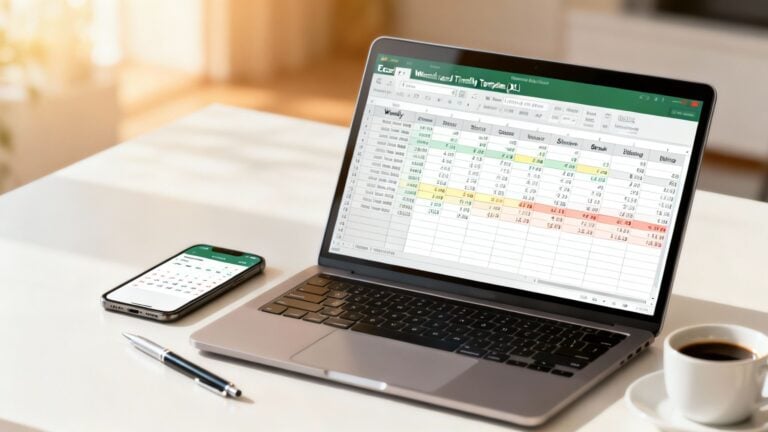Effective project time management is all about tracking time accurately and efficiently. Imagine this: You’ve just landed a new client, and you’re excited to get started on their project. Time tracking best practices could have helped you identify this discrepancy much earlier, so you could course-correct and avoid going over budget. Instead, you’re left scrambling to get the project back on track before you lose your client’s trust. This scenario is all too common, but it doesn’t have to be. This article will outline time tracking best practices to help you and your team more effectively manage your time when working on projects.
One way to implement these best practices is by using automatic time tracking software, such as Tackle. This tool helps teams identify trends and uncover insights into their time management skills, enabling them to improve project performance.
What is Time Tracking?

Time tracking is the practice of monitoring and recording the amount of time spent on various tasks, projects, or activities. This process is typically facilitated by time tracking software or apps, which help individuals and teams:
- Stay organised
- Maintain accuracy
- Manage their workload effectively
For businesses, time tracking is essential for a number of reasons. It enables organisations to:
- Log billable hours
- Assess employee productivity
- Monitor project progress
- Ensure accurate payroll
By understanding exactly how time is allocated, managers can make better decisions about staffing, budgeting, and deadlines. Beyond business, time tracking also supports individuals in:
- Identifying time-wasting habits
- Improving focus
- Becoming more accountable
Whether you’re a freelancer tracking client work, a team leader balancing multiple projects, or an HR manager overseeing attendance, time tracking offers the visibility and control needed to optimise both productivity and performance.
Related Reading
- Is Time Tracking Effective
- How to Keep Track of Projects at Work
- Project Delivery Management
- Project Progress Tracking
30 Time Tracking Best Practices for Individuals and Teams

1. Start With a Transparent Time Tracking App
First, find a time tracking app that offers transparency, user-friendliness and detailed reports. Make sure to take the time to ensure your team is comfortable with all of the features of whatever app you end up choosing.
Communication is key. Tackle, for instance, provides comprehensive and automated time tracking features that offer complete visibility into your team’s performance, making the process more transparent than ever.
2. Develop a Strict Tracking Methodology
Finding the best time-tracking methodology for your organization is essential. Every company is different, but consider factors such as deadlines, completion dates, milestones and any other relevant information to ensure you select an approach that works for you.
Some companies track time based on projects, activities, tasks, or clients. Ensure it aligns with your organizational needs, and then adhere to it.
3. Start With a Test Case First
For a successful implementation of the time tracking system, it is essential to begin with a test case. This will give you an understanding of how the system works and if its capabilities fit your business requirements. To assess data accuracy, try tracking several tasks in detail. Failing to do so could lead to wasting valuable resources if the system does not meet your organization’s expectations.
4. Set Measurable Goals and Objectives
When it comes to tracking time, you must set tangible objectives that can be measured accurately. This will enable you to evaluate your team’s progress and track their performance. For example, a goal could be to reduce costs by 5% in the next quarter or increase profits by 10%.
Having measurable goals enables better decision-making when selecting a time tracking system. Modern apps like Day.io integrate effortlessly with budgeting tools and other project management software for this purpose.
5. Set a Leave Schedule
When overseeing a project with a tight deadline, it is crucial to consider the leave schedules of your team members. This will help you effectively plan out the project and ensure that all tasks are finished on time.
Utilize an employee leave calendar through your time tracking system to keep everyone in the team organized and aware of their work schedules. Doing so guarantees the timely completion of each task.
6. Do Not Overemphasize Monitoring
Monitoring your team’s performance is essential, but it should not be done excessively. You can set reasonable expectations and ensure the time tracking system does not become overly intrusive. Several research findings have shown that excessive monitoring can harm the morale of team members.
Ensure that your time tracking system is efficient for your team and they are comfortable using it. Leverage communication channels such as Slack to stay connected with them and provide feedback.
7. Use Both Automated and Manual Entry System
If you’re looking for an efficient and accurate way to track time, combined automated and manual entry systems are the best solution. Automated time tracking utilizes conditional automation, which turns on when specific conditions are met. Although there are times where manual entry is necessary, using both automated and manual monitoring ensures optimal efficiency.
The latter lets you handle edge cases. For instance, if you have complex tasks or multi-year projects to track, manual entry makes more sense.
8. Choose an App That Comes With a Native Timesheet Feature
Your time tracker might include a timesheet feature to help you accurately track the work of your team members. Timesheets give you a live overview of how much time each person is spending on their tasks, making it significantly easier for managers to analyze data and make better decisions on short notice.
If you have to create manual timesheet entries by exporting the project data to Excel, CSV, or other formats, it can create extra work and consume more time. Tackle, for instance, allows you to create highly customizable timesheets with tracked data in real-time.
9. Use Anti-fraud Features
Most time tracking systems are equipped with anti-fraud features to help detect any fraudulent activities. Implementing these measures, such as user authentication, IP address detection and access control, is essential in securing your data and preventing unauthorized access.
10. Include Non-billable Hours in Your Tracking Data
You may be tempted to only track billable hours, but it is essential that you also include non-billable hours in your data. From planning and research to training, this information will prove invaluable when making decisions related to resource allocation and productivity optimization.
Project managers and HR departments alike can benefit from tracking non-billable hours for valuable insights.
11. Automated Time Clock
An automated time clock is a great way to keep track of the working hours of your team members. It can also help you monitor their attendance and productivity levels. Automated clock-in, clock-out apps like Tackle are perfect for small businesses that need an easy-to-use solution. This app allows you to track time for multiple projects with just a few clicks.
12. Don’t Forget to Track Attendance
For many industries, tracking attendance alongside time can provide invaluable insight into employee hours and whereabouts. Biometric scanners or computerised systems are great tools to ensure accurate attendance tracking.
13. Track Activity Levels
Time tracking data may not give you the full picture of your team’s performance. Therefore, you should track activity levels as well. This will help you understand how long each task took and how productive your team was in completing it. Your time tracking app may track activities in several ways, such as:
- Taking screenshots
- Recording video or picture using the webcam
- Using tracking widgets
- Monitoring user activity and desktop usage based on keyboard and mouse strokes
If you spot any unusual activity, act fast and identify the issue. You may also want to contact the relevant team member. Although there are many apps for tracking activity, be cautious not to store sensitive data, such as passwords or other confidential information, in keystrokes.
14. Spend Time For Task Categorization
Task categorization is essential when you begin time tracking. Although it may seem unnecessary for small projects, as your business grows, correct categorisation will provide invaluable insights into team performance and help you effectively allocate resources.
Tackle enables the effective management of multiple projects and tasks per client, making task categorization easier than ever.
15. Make Use of Integrated Budgeting Features
Maximize the accuracy of your project budgeting with integrated budgeting features in your time-tracking system. Set a budget for each task or activity and track it in real-time to ensure that no unexpected costs arise.
16. Configure Real-time Notifications
One of the core use cases of most time tracking apps is real-time alerting. These notifications can be configured in the app, letting you know when any task or project is completed and when deadlines are approaching. This will ensure that your team remains on track and meets its targets within specified timelines.
17. If You Don’t Track Time Already, Consider a Pilot Program
It makes sense to try a new system to make sure it’s a good fit for your team. Select a group of people who can join a pilot program and share their feedback. Try to invite those who are motivated and would like to track their time and analyse the gathered information. Their feedback would be more valuable.
18. Approximate Time When You Forget to Start the Timer
When you use the timer, you’ll often end up forgetting to start it or switch it off. This is very common. Instead of trying to be perfect, it’s best to have a strategy in place when unexpected events like this occur. When you forget to start or stop the timer, simply approximate the time, enter it manually, and proceed.
If a timer is already running for a different activity, stop it, estimate and subtract the time spent on the other task, and manually create a new time entry for the missing activity.
19. Keep the Data Entry as Simple as Possible
The fewer details you need to fill in, the greater the chance that timesheets in your timesheet app will be accurate. But how much detail do you need? It depends on how granular you need the reports to be. For example, do you need to know how long it took to fix some bug, in total? Or do you need to know how much time each activity took (finding the cause, coding, and testing)?
Depending on the answer, you simply file the entire entry under the respective project and tag it QA, or you’ll create multiple entries, each with its description and tag. Just keep in mind that the easier you make time tracking to people, the more accurate timesheets will be.
20. Use the Pomodoro Technique
The Pomodoro Technique involves working in focused intervals of 25 minutes followed by a five-minute break. After completing four Pomodoro intervals, you take a more extended break of 15 to 30 minutes. How does the Pomodoro technique help? It breaks work into manageable segments to reduce mental fatigue and increase focus. It also encourages you to work with the time you have, rather than against it.
21. Have Clear Goals
Sure, efficient and comprehensive time tracking is vital for billing clients, but you may find in your reports that I spend too much time in one area. Identifying key goals to track in your time management will help improve efficiency and forecasting.
Focus on What Matters
You’ll soon realise you have more time for your clients, your team, and you! If you want to improve your efficiency, even dramatically in some cases, pick an intelligent time tracking solution and stick with it, especially if you can use time tracking as a way to invoice clients. And if your time tracking platform isn’t doing enough for you, shop around.
22. Assign Someone to Check Timesheets Every Single Day
When you first introduce time tracking, the process will be spotty. People often forget to fill out their timesheets, or they wait too long and become frustrated. So, put someone in charge of checking timesheets and reminding people to fill them out before they leave work. It doesn’t have to be a manager; anyone can do it.
You can even automate the process (in case everyone is too nice or shy). Time tracking software can send regular reminders to track time if a person hasn’t logged a targeted number of hours; you just have to set the rules for who gets them and when.
23. Make Time Tracking Data Transparent
You can limit who can see time tracking entries to admins or everyone. For some data, it’s okay to limit access only to admins (in the case of private projects). But you should strive to make the process transparent. Others will be able to see who worked on what, see that people are regularly filling their timesheets, and be motivated to do the same (ie. follow the crowd).
If the team is competitive, you can even enable the Team Dashboard so people can see who tracked the most time. A little bit of competition is a good thing, as long as there’s no extrinsic reward.
24. Automate Tasks
In any recent guide with time-tracking best practices, you’ll come across automation. Gathering data manually is rather monotonous and repetitive, and in all fairness, there’s no longer added value to it. Therefore, there are a few things that are extremely important to automate, which will allow you to save a significant amount of time.
The Cost of Repetition
Just out of curiosity, did you know that without a task automation app, an average employee spends about 3 hours a day repeating the same tedious task instead of focusing on more creative projects? This has resulted in decreased work productivity, effectiveness, and motivation for many companies everywhere.
Automation’s Time-Saving Impact
Reports show that companies that adopted work automation had nearly 60% of their employees saving six or more hours a week when some repetitive aspects of their jobs were automated. This is possible because workplace automation can handle about 45% of repetitive tasks.
25. Use Automated Task Reminders
By integrating automated task reminders into your daily routine, you can improve your productivity and avoid missing deadlines. You can opt in to receive automated, timely alerts for upcoming tasks, deadlines, or meetings to keep your schedule on track.
For example, when creating a task or meeting event in Google Calendar, you can tick the Add Notification option. You’ll receive an email or pop-up notification at your specified time before the event.
26. Time Tracking With Leave Schedule
Maintaining harmony in the work environment is very important to have clear and concise leave management. Nevertheless, calculating leave days for every employee can be a hectic job for every manager. So if you use a time tracking app that gives you the total insight into your employee’s working days and leaves days, then you will be able to compensate your employees accordingly.
27. Prevent Over-monitoring
The old proverb goes, “Excess of everything is bad.” Yes, that is true. Employees must not feel that they are being overwatched. Otherwise, their productivity will decrease due to pressure, and employees may switch jobs because of uncomfortable situations. Demonstrating trust among the employees will make them feel comfortable.
To avoid over-monitoring, a quick check-in structure may be helpful. With proper workload management, a manager can also prevent over-monitoring.
28. Time Tracking in Real-time From Different Time Zone
A remote team or office working from home may have expatriate employees. Hiring a customer service employee or agency in the USA costs a lot, but you can get the same facility from outsourcing or BPO. Time tracking with a real-time feature will give you the exact working hours of your outsourced employees.
29. Provision of Sharing Reasons by Employees for Unproductive Time
There may be unforeseen situations in which employees must temporarily avoid tasks to solve problems. For example, incidents such as a medical emergency, a child’s emergency, or a parent’s emergency may occur, in which the employee has no choice but to address the issue.
In that instance, if the employee can discuss the explanation for the unproductive time, the transparency improves, and a healthy working atmosphere is observed.
30. Project-based Time Tracking
A worker might work on several projects. Time tracking can be effortless if users can track their working time by synchronising with the projects. This will help both employees and employers get an overview of the working time required to complete a project. In that case, managers can allocate a definite time to future projects by examining the previous time record.
Project-based time tracking is also helpful for paying wages by calculating the total time required and ensuring the budget is met.
31. Use Data to Make Decisions
The ability to make crucial decisions using time-tracking software becomes fact-based, providing valuable inputs for more informed management in general. This leads to improvement within the company, as the end-user understands their work style and what needs to improve.
With time tracking, a manager comprehends the skill and ability issues within the team and what kind of changes must be done to make things work smoothly. Time tracking also helps in understanding a team’s dynamics while segmenting performance across multiple dimensions.
Factors Influencing Performance
Performances will always vary depending on many factors, such as:
- Skillsets
- Education
- Managers
- Employee’s location
Nevertheless, rich data generated by time-tracking software will provide insights needed to run operations at a high capacity and maximum efficiency.
Related Reading
- Client Project Management
- Best Project Management Software for Creative Agency
- Agency Resource Management Software
- Best Agency Project Management Software
- Monday.com vs Basecamp
- Monday.com vs Jira
- Creative Agency Resource Management
Choosing the Best Time Tracking Tools

Not all time tracking tools are created equal. Picking the wrong one can make your workflow more complicated than it needs to be. The best tools don’t just record time; they help you understand it. Start by thinking about how you and your team work. Do you rely heavily on calendars?
Are you juggling multiple clients or internal projects? Do you need to track billable vs. non-billable hours?
Look for Automatic Time Tracking Features
Look for tools that offer automatic time capture, so you’re not constantly starting and stopping timers. Seamless integrations with your existing tools (like Google Calendar, Slack, Notion, or Trello) can save hours every week. You also want flexible reporting, something that turns raw data into actionable insight, whether that’s for invoicing, team reviews, or resource planning.
Pick a Tool That’s Simple to Use
Above all, it should be easy to use. If the tool feels like a chore, no one will stick with it. Try a few options, test them with real tasks, and choose the one that helps you track time without wasting it.
Benefits of Time Tracking for Individuals and Teams

When you start tracking your time, you immediately gain a clearer picture of how your day is spent. It’s easy to underestimate how much time gets lost to distractions or low-value tasks. But with tracking in place, people tend to work with more focus, and teams begin prioritising what truly matters.
If you’re someone who often feels like the day slips away without much to show for it, you’re not alone. Only one in five people feels in control of their daily workload. That lack of control adds up.
According to research, the US economy loses about 50 million hours of productivity each day due to unrecorded work. Time tracking doesn’t just help you stay productive; it helps reclaim that lost potential.
Boosting Team Morale and Reducing Burnout
When projects are allowed to drag on endlessly with no clear targets, team members can quickly become demoralised. Tracking time on projects helps eliminate this problem, creating a sense of urgency and assisting teams to meet their goals. As time tracking gives clear visibility into project progress, it can reduce stress and improve team morale.
Time tracking enables better resource allocation and helps rebalance workloads to reduce burnout.
Improving Project Forecasting and Planning
Accurately tracking time on projects can help improve future project planning and forecasting. This is because you can build a detailed picture of how long tasks and projects take your team, rather than relying on guesswork or assumptions. Over time, this will help you create more accurate project plans and improve your team’s overall productivity.
Better Resource Allocation
At a team level, time data reveals what’s happening behind the scenes. You can spot which projects are demanding too much time, which staff are overwhelmed, and where there may be room to optimise.
This kind of visibility enables managers to reassign work more effectively and make more informed resourcing decisions. Over time, it leads to more balanced workloads, fewer bottlenecks, and better outcomes.
Accurate Payroll
For businesses, manual time entry can lead to mistakes, disputes, or even payroll errors. Time tracking automates the process, ensuring employees are paid fairly for the exact hours they’ve worked. It reduces administrative workload, builds trust, and facilitates audits or compliance checks.
When everyone’s time is logged consistently, payroll becomes faster, cleaner, and more accurate.
Related Reading
- Microsoft Project vs Trello
- Monday vs. Asana
- Monday.com Competitors
- Jira vs Basecamp
- Basecamp Competitors
- Bonsai Alternatives
- Asana Alternative
- Trello Alternative
Start Using Our Automatic Time Tracking Software for Free with One Click Today
Automated time tracking software eliminates the manual work associated with time tracking. This means no more starting and stopping timers or filling out timesheets. Instead, the software runs in the background and automatically tracks the time you spend on different tasks and projects without interrupting your workflow.



